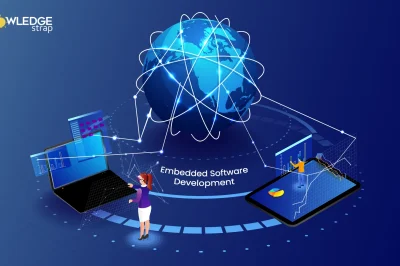In today’s technology-driven world, innovation often happens behind the scenes. While we are quick to marvel at the sleekness of smartphones or the intelligence of autonomous vehicles, much of the magic lies hidden—inside tiny chips and specialized hardware, powered by something known as embedded software.
Embedded software development is a niche yet crucial branch of technology that enables countless devices, systems, and industries to function seamlessly. From smart watches to space shuttles, embedded software ensures that everything runs efficiently, reliably, and often without the user even realizing it.
In this blog, we’ll explore what embedded software development is, why it’s so important, and the key trends shaping its future.
What is Embedded Software Development?
Embedded software refers to specialized programming designed to operate hardware devices that are not typically considered computers. Unlike standard software applications (like web browsers or word processors), embedded software is purpose-built for specific functions, often in real-time environments.
An embedded system can be something simple like a microwave oven controller, or complex like the flight control systems in aircraft. Regardless of complexity, these systems must be:
- Reliable: Minimal errors, often running for years without failure.
- Efficient: Operate with constrained resources (limited memory, processing power, etc.).
- Specialized: Tailored precisely to the hardware and its specific purpose.
Embedded software development is the process of designing, coding, testing, and deploying this kind of software.
Key Components of Embedded Systems
Embedded software is tightly coupled with hardware. Here are some core components that developers work with:
- Microcontrollers (MCUs): These are compact integrated circuits that contain a processor, memory, and input/output peripherals. Examples include STM32 or Arduino boards.
- Real-Time Operating Systems (RTOS): Lightweight operating systems that manage time-sensitive tasks efficiently. Examples: FreeRTOS, Zephyr, VxWorks.
- Device Drivers: These facilitate communication between the hardware and the rest of the system software.
- Firmware: A type of embedded software stored permanently in hardware (typically ROM) that helps devices boot up and function.
The Embedded Software Development Process
Creating embedded software requires a meticulous and often hardware-dependent process. Here’s a typical workflow:
1. Requirement Analysis
Understanding the device’s function is critical. Is it controlling a robot arm? Monitoring air quality? Each function dictates the software’s complexity, real-time constraints, and hardware requirements.
2. Hardware Selection
Choosing the right microcontroller, sensors, communication modules (Wi-Fi, Bluetooth, etc.), and memory based on the project’s needs.
3. Software Architecture Design
Planning the overall structure:
- Task scheduling
- Memory management
- Communication protocols
- Power consumption optimization
4. Coding
Embedded developers usually program in C or C++, although Assembly is sometimes used for highly resource-constrained devices. Python is also emerging for prototyping IoT devices.
5. Testing and Debugging
Testing in embedded development is rigorous. It often involves:
- Unit testing for code modules
- Hardware-in-the-loop (HIL) testing
- Stress and performance testing under different real-world conditions
6. Deployment and Maintenance
Once validated, the firmware is flashed onto the device. Post-deployment, many modern embedded systems allow over-the-air (OTA) updates to fix bugs or add new features.
Challenges in Embedded Software Development
Despite its importance, developing embedded software is fraught with unique challenges:
– Limited Resources
Memory, processing power, and battery life are often extremely limited compared to general-purpose computers.
– Real-Time Constraints
Many applications (like automotive braking systems) require responses within microseconds, leaving no room for error or delay.
– Hardware Dependence
Software developers often have to wait for prototype hardware to be built—or worse, debug problems that could be due to either hardware or software.
– Security
Embedded devices are increasingly connected to networks (think IoT devices). However, many still lack robust security, making them targets for cyberattacks.
Trends Shaping the Future of Embedded Software
The embedded industry is evolving rapidly, fueled by advances in AI, connectivity, and automation. Some key trends include:
1. Rise of the Internet of Things (IoT)
With billions of connected devices expected by 2030, embedded software will increasingly need to manage wireless communications, remote control, and data security at scale.
2. Edge Computing
Instead of sending data to centralized servers, embedded devices are starting to process data locally (“at the edge”), enabling faster response times and better privacy.
3. Artificial Intelligence (AI) Integration
Microcontrollers are becoming powerful enough to run lightweight AI models, enabling smarter decision-making on devices like cameras, drones, and industrial sensors.
4. Safety-Critical Development
Industries like automotive (especially with autonomous driving) and healthcare demand even higher standards of safety and reliability. Compliance with standards like ISO 26262 and IEC 62304 will become more widespread.
5. Open Source Ecosystem
Projects like Zephyr RTOS and TensorFlow Lite for Microcontrollers are lowering the barrier for entry and accelerating innovation in embedded development.
Skills Needed for Embedded Software Developers
If you’re considering entering this field, here are the essential skills to master:
- Programming: C and C++ are non-negotiable. Python and Assembly are helpful.
- Hardware Knowledge: Understand microcontrollers, circuits, and protocols like UART, SPI, and I2C.
- Real-Time Systems: Know how to build and manage systems that must react instantly.
- Debugging: Proficiency with oscilloscopes, logic analyzers, and in-circuit debuggers (e.g., JTAG).
- Problem-Solving: Creativity and resilience are essential when dealing with constraints.
Conclusion
Embedded software development might not always grab headlines, but it is the silent force powering our modern lives. As devices become smarter, faster, and more connected, the importance of robust, efficient embedded systems will only grow.
Whether it’s ensuring your car brakes at the right moment, making your smartwatch track your heartbeat accurately, or helping factories run robotically at peak efficiency, embedded developers are building the invisible engines of progress.
If you have a passion for low-level programming, hardware tinkering, and solving tough challenges, embedded software development offers an exciting, impactful career path.






